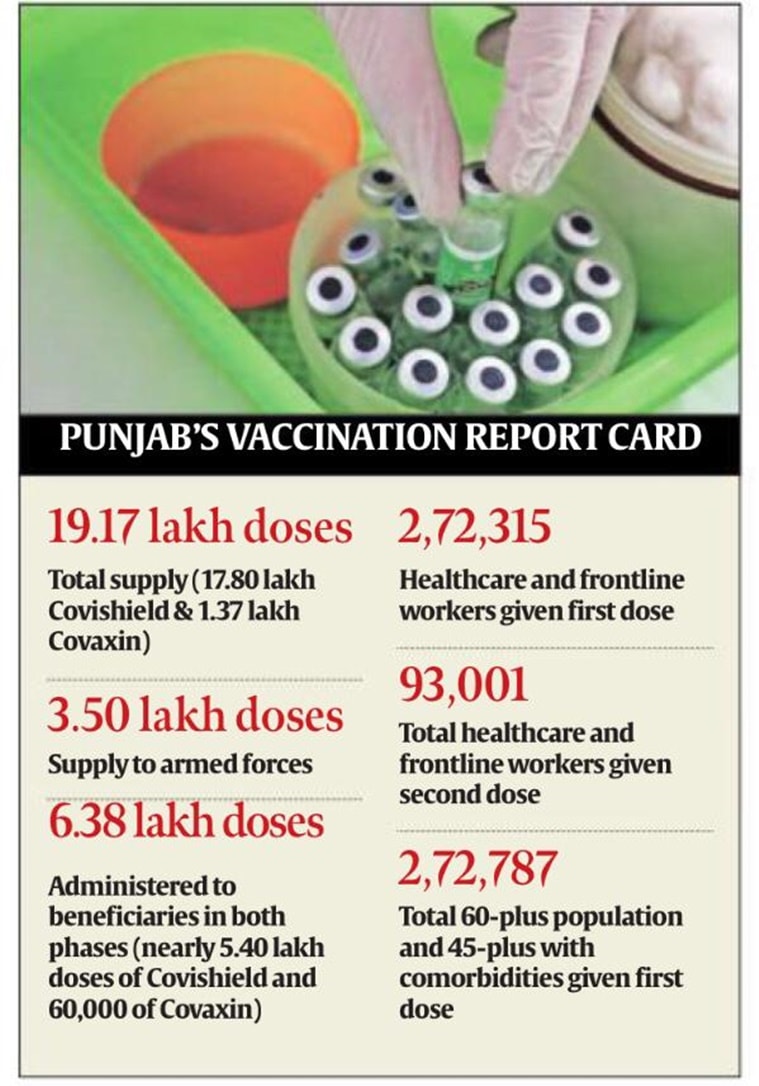Even while Punjab CM Amarinder Singh has urged the Union government to accelerate the vaccination drive and widen its ambit, data shows that the state has not yet consumed even half of the total doses supplied by the Centre since the drive started on January 16 this year.
Punjab health officials said that they have received the supply of 19.17 lakh doses (17.80 lakh doses of Covishield and 1.37 lakh doses of Covaxin) till now, of which 3.50 lakh doses were supplied to the armed forces.

Of the remaining 15.67 lakh doses, just 6.38 lakh doses have been administered to the beneficiaries of phase I and phase II, as per the latest data till Wednesday. This translates to just 40.71 per cent consumption within the state.
 With a total of 4.68 lakh frontline and healthcare workers registered till now (2.54 lakh healthcare workers and 2.14 lakh frontline workers), Punjab has vaccinated around 58 per cent of them with first dose.
With a total of 4.68 lakh frontline and healthcare workers registered till now (2.54 lakh healthcare workers and 2.14 lakh frontline workers), Punjab has vaccinated around 58 per cent of them with first dose.
Dr Rajesh Bhaskar, nodal officer, Covid-19, Punjab, said, “We have received total supply of 17.80 lakh Covishield doses and 1.37 lakh doses of Covaxin till now. As per the orders from the Centre, 3.50 lakh doses were directly supplied to the armed forces. Of the remaining lot of 15.67 lakh doses, we have administered 6.38 lakh doses to the beneficiaries. We still have more than 9 lakh doses in stock which is sufficient enough. There is no dearth of vaccines. We will try to finish the first lot before its expiry date.”
In Punjab, nearly 5.40 lakh doses of Covishield and 60,000 doses of Covaxin have been administered to the beneficiaries, said Dr Bhaskar.
A tussle, meanwhile, is on between the Centre and Punjab government regarding vaccine wastage and the data being cited by both has been showing a mismatch. While state health officials say that as per the field reports, just 1 per cent of Covishield and 3 per cent of Covaxin doses have been wasted, the Union Ministry of Health and Family Welfare has pegged vaccine wastage in Punjab at 8 per cent.
“According to the reports that we have received from the field, vaccine wastage in Punjab has just been 1 per cent for Covishield and 3 per cent for Covaxin but the Centre has calculated our wastage at 8 per cent. We have sent them the updated data as there were some issues in entering the data on their portal,” said Dr Bhaskar.
Story continues below this ad
As per the latest data till Wednesday evening, a total of 2.72 lakh beneficiaries (healthcare and frontline workers) have been vaccinated in Punjab with the first dose and 93,001 with the second dose. In the second phase, 2.72 lakh beneficiaries (60+ population and 45+ with comorbidities) have been vaccinated with the first dose.
With a total of 4.68 lakh frontline and healthcare workers registered till now (2.54 lakh healthcare workers and 2.14 lakh frontline workers), Punjab has vaccinated around 58 per cent of them with first dose. Dr Bhaskar said that after the commencement of on-the-spot registration, the number of registrations have increased in both categories.
“Initially there was too much of vaccine hesitancy and despite our best efforts, even healthcare workers were not eager to get vaccinated but now situation is improving. Also, we are increasing both government and private centres where vaccination can be taken,” he said.
Dr Rajesh Kumar, Executive Director, State Health Systems Resource Centre, Punjab, said that situation in Punjab cannot be compared to other states such as neighbouring Haryana because health infrastructure in the border districts was still poor.
Story continues below this ad
“Initially in January and February when the drive started for healthcare and frontline workers only, it was a very new vaccine with people having very less knowledge about it. There were media reports on apprehension regarding trials and hurried up approvals so even healthcare workers were not that willing to get vaccinated. But now with states having their own data and case studies, healthcare workers coverage has increased gradually and confidence has increased with experience. Secondly, in January and February when drive was launched, pandemic was on decline and there were hints that it was nearly over so people thought it was okay to not get vaccinated but with this second wave, people now know that there can be a third wave too and there is indeed a need to get the vaccine,” Dr Kumar said.
“Initially, there were also many hiccups in CoWin app. Punjab’s situation cannot be compared with other states, not even Haryana because we still have border districts such as Fazilka, Tarn Taran, Gurdaspur where health infrastructure is still poor. But now with community and primary health centres at village level also being included in the drive, numbers will gradually go up,” he added.
Dr Rajesh Kumar added that to accelerate vaccination from April 1 when every person above 45 can get the jab, district level task force teams have been constituted in Punjab to focus on district-specific issues and strategise on the lines of polio immunization drive to cover maximum beneficiaries.



 With a total of 4.68 lakh frontline and healthcare workers registered till now (2.54 lakh healthcare workers and 2.14 lakh frontline workers), Punjab has vaccinated around 58 per cent of them with first dose.
With a total of 4.68 lakh frontline and healthcare workers registered till now (2.54 lakh healthcare workers and 2.14 lakh frontline workers), Punjab has vaccinated around 58 per cent of them with first dose.





